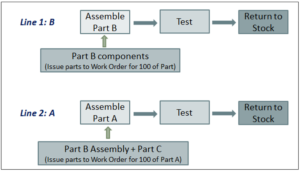The three main benefits of lean manufacturing, if implemented correctly, are 1) a reduction in inventory levels 2) it exposes inefficiencies on the production floor and 3) it reduces waste. One of the key elements of lean manufacturing is the deployment of a Kanban system.
While there different types of Kanban systems, a simplistic definition is it represents a Demand-Pull production approach where customer orders dictate what is manufactured as opposed to the more traditional Demand-Push where the manufacturing organization is tasked with producing specific quantities for specific parts to meet an approved sales forecast for a given period. One of the critical keys to success of a Kanban system is to have an efficient/effective Just-in-Time inventory system so that inventory can be delivered to the factory quickly to satisfy inventory requirements for an order received.
Technically, a Kanban inventory system uses a Kanban (a graphic or visual signal; e.g. color coded cards or lights) that indicate to manufacturing to produce another unit or to replenish inventory on-the-manufacturing-line. Its intent is to minimize inventory levels on the manufacturing floor and to control the quantity of production for a particular product.
A simple example is described below in Scenario 1:
- An order is received for 10 units of Part A
- Part A’s top level Bill-of-Material is sub-assemblies B plus one Part C
- The manufacturing floor is comprised one line with a 3 step process:
- Process 1: Build sub-assembly B
- Line 2: Build Part A (Part B + Part C)
- Test

The manufacturing process would be:
- Issue a Green card to Line 1 to build 10 units
- In-line inventory actions:
- If all inventory levels were sufficient at the time the green card was received, use in-line inventory to assemble 10 of Part B and 10 of Part A
- If after manufacturing the order, additional in-line inventory is required the impacted manufacturing location(s) will post a Red card.
In comparison, if a Work Order system is used (Scenario 2) then the below manufacturing process would be used. The important element in this scenario is the 10 units for Part A were considered part of the 100 unit forecast that manufacturing used in their production planning.
Scenario 2

The two biggest risks that often are associated with Kanban are 1) if a large order quantity is received, the Kanban system may find it difficult to produce the required quantity in time for the requested delivery date to the customer and 2) If the manufacturing production cycles are long the manufacturing floor space required to keep the production flowing might become extensive.
